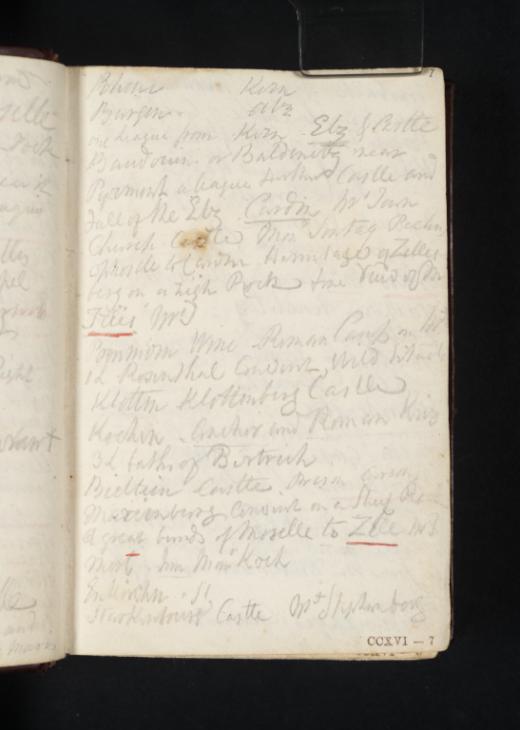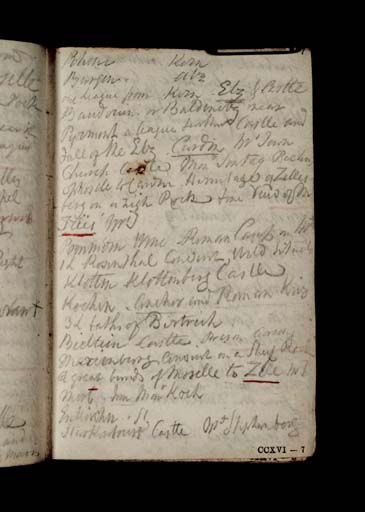Joseph Mallord William Turner Notes of Sights between Koblenz and Trier 1824
Image 1 of 2
Joseph Mallord William Turner,
Notes of Sights between Koblenz and Trier
1824
Joseph Mallord William Turner 1775–1851
Folio 7 Recto:
Notes of Sights between Koblenz and Trier 1824
D19564
Turner Bequest CCXVI 7
Turner Bequest CCXVI 7
Pencil and pen and red ink on white wove paper, 118 x 78 mm
Inscribed in pencil and pen and red ink by Turner (see main catalogue entry)
Inscribed in blue ink by Ruskin ‘7’ top right
Stamped in black ‘CCXVI–7’ bottom right
Inscribed in pencil and pen and red ink by Turner (see main catalogue entry)
Inscribed in blue ink by Ruskin ‘7’ top right
Stamped in black ‘CCXVI–7’ bottom right
Accepted by the nation as part of the Turner Bequest 1856
References
1909
A.J. Finberg, A Complete Inventory of the Drawings of the Turner Bequest, London 1909, vol.II, p.668, as ‘“Treves. 24 Leagues by Land from Coblenz. 49 by Moselle; and...list of places on the River Moselle, from Coblenz’.
1978
Agnes von der Borch, Studien zu Joseph Mallord William Turners Rheinreisen (1817–1844) (Ph.D. thesis, Rheinischen Friedrich-Wilhelms-Universität, Bonn 1972), Bonn 1978, pp.61–2.
1980
Agnes von der Borch and Gerhard Bott, J.M. William Turner: Köln und der Rhein: Aquarelle Zeichnungen Skizzenbücher Stiche, exhibition catalogue, Wallraf-Richartz-Museum, Cologne 1980, p.86.
1997
Inge Herold, Turner on Tour, Munich and New York 1997, pp.66–7 (reproduced as ‘CCXVI 4v’).
1991
Cecilia Powell, Turner’s Rivers of Europe: The Rhine, Meuse and Mosel, exhibition catalogue, Tate Gallery, London 1991, pp.37 note 1 [p.60], 122 no.36.
1995
Cecilia Powell, Turner in Germany, exhibition catalogue, Tate Gallery, London 1995, pp. 30 notes 3 and 4 [p.77], 30– 1 fig 16, 152 no.77.
1995
Cecilia Powell and Pia Müller-Tamm, William Turner in Deutschland, exhibition catalogue, [Städtische] Kunsthalle Mannheim 1995, p.38 fig.16.
This is the second of four pages of notes Turner took from the ‘Third Excursion’ section of Alois Wilhelm Schreiber’s The Traveller’s Guide down the Rhine (see also Tate D19563, D19565–D19566; Turner Bequest CCXVI 6a, 7a–8). The manuscript notes on these pages list the names of towns and the distances between them, sites of historical interest, antiquities, picture collections, inns and travel information for the journey between ‘Coblentz to Trêves’ when travelling ‘the course of the Moselle’.1 Turner’s use of Schreiber’s guidebook, published in English in 1818, is discussed in the general Introduction to this tour.
The artist’s notes are transcribed thus:
‘Rhon Kern
Burgen Eltz
one League from Kern Elz & Castle
Baudouin or Baldwin, near
Pyrmont a League further Castle and
Fall of the Elz. Cardin Mt Town
Church Castle Monr Sontag Pictures
opposite to Carden Hermitage of Zilles
berg on a high Rock fine View of M
Trëis Mt T
Pommern Wine Roman Camp on Mt
I L Rosenthal Convent Wild Situation
Klotten Klottenberg Castle
Kochen Anchor and Roman King
3 L baths of Bertich
Bilstein Castle Prison Convent
Marienberg Convent on a Steep Rock
A great bend of Moselle to Zell Mt T
Merl Inn Monr Koch
Enkirchen St
Starkenbourg Castle Mt Stephanberg.’
Burgen Eltz
one League from Kern Elz & Castle
Baudouin or Baldwin, near
Pyrmont a League further Castle and
Fall of the Elz. Cardin Mt Town
Church Castle Monr Sontag Pictures
opposite to Carden Hermitage of Zilles
berg on a high Rock fine View of M
Trëis Mt T
Pommern Wine Roman Camp on Mt
I L Rosenthal Convent Wild Situation
Klotten Klottenberg Castle
Kochen Anchor and Roman King
3 L baths of Bertich
Bilstein Castle Prison Convent
Marienberg Convent on a Steep Rock
A great bend of Moselle to Zell Mt T
Merl Inn Monr Koch
Enkirchen St
Starkenbourg Castle Mt Stephanberg.’
The journey along the Moselle from Alken and Burg Bischofstein brought the traveller to the villages of Rhom and Burgen, ‘where there is a nursery and a quarry of ragstones’.2 On the right bank, at the village of Kern, the ‘torrent of the Elz’ joins the Moselle and flows towards the market town of the same name; there, also, is castle of Elz, besieged by ‘Bishop Baldwin’ in 1391.3 One league’s distance from this place are ‘the ruins of the castle of Pyrmont’ and a picturesque view of the River Elz in cascade.4 From here, the traveller takes the road to Carden, a market town and ‘formerly an archdeaconship with a collegiate church and a castle’.5 Here, Turner takes note of Schreiber’s recommendation to see the ‘very interesting pictures of the old German school’, belonging to the ‘ci-devant mayor, M. Sonntag’.6 On the opposite bank to Carden, ‘on the point of a very high rock’, is the ‘hermitage of Zillesberg’, whilst its neighbours are the townships of Tries and Pommern ‘where an excellent red wine is made’.7 Close by, ‘at the top of a mountain’ appear ‘the traces of an ancient Roman camp’, and ‘a league beyond it’ in the ‘interior of the country’ stands the ‘ancient convent of Rosenthal, in a very wild but picturesque situation’.8
Following the course of the Moselle, the traveller proceeds to Klotten, with the ruins of the medieval Klottenbourg Castle in view. From Klotten, the next town is ‘Kochem’ (Cochem), where Schreiber writes that the local inns there are ‘The Anchor’ and the ‘Roman King’.9 An excursion can be made from Cochem ‘three leagues’ in distance to the ‘baths of Bertrich’, where a hermit of that name was reputed to have established residence on the site of a hot springs.10 Schreiber writes that the baths had lain in a ‘bad state’ until their renovation in 1760, enabling locals and visitors to enjoy ‘fourteen’ new bathing rooms plumbed with pipes containing spring water at a balmy ‘twenty-four degrees’.11
The next town on Schreiber’s itinerary was Beilstein, presided over by a castle belonging to the ‘Counts (now Princes) of Metternich-Winneburg’.12 In the town itself has ‘a convent of Carmelites’ and within it, ‘a curious prison for confining the monks’.13 The ruins of another convent, the Marienbourg, lie close to Beilstein. This nunnery, ‘situated on a steep rock, and defended by towers, ditches and drawbridges’ was secularised and converted into a fort in 1514 by Archbishop Baldwin.14
The Moselle then ‘forms an immense bend’, which Schreiber warns the traveller ‘better not follow’, recommending the road to Zell instead; the land is fertile here, abundant in ‘corn’, ‘wine, fruits, and flax’.15 In terms of accommodation, Schreiber advises that the best inn at Zell is ‘that kept by M. Koch’, a point duly recorded by Turner.16 This page concludes with a note on the village of Enkirchen and Starkenbourg, a town overlooked by the vestiges of an old castle which was ‘formerly the residence of the Counts of Sponheim-Starkenbourg, but is now only a heap of ruins’.17 Finally, the vista and environs of the Stephansberg (Mount St Stephen) is recommended, not least for the ‘excellent wine’ produced there.18
Alice Rylance-Watson
February 2014
How to cite
Alice Rylance-Watson, ‘Notes of Sights between Koblenz and Trier 1824 by Joseph Mallord William Turner’, catalogue entry, February 2014, in David Blayney Brown (ed.), J.M.W. Turner: Sketchbooks, Drawings and Watercolours, Tate Research Publication, April 2015, https://www


